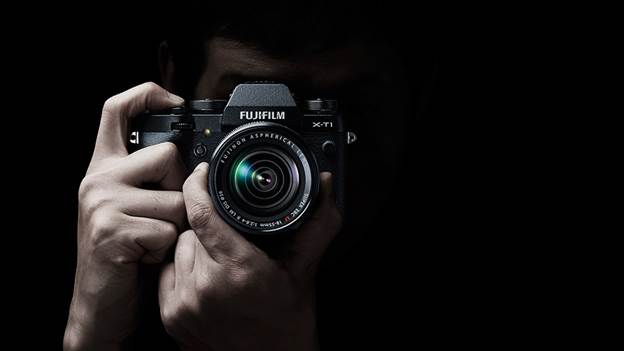Fujifilm can be credited for starting the
retro-camera design craze that has resulted in getting some stylish and
well-constructed bodies that feature all-metal enclosures, durable buttons and knobs,
as well as the look, feel, and handling that harkens back to the golden days of
manual photography and premium rangefinder cameras.

Fujifilm
X T1 Body Under the ISO speed dial, is the drive mode dial,
which includes advanced shooting modes
Feature
Fujifilm has upped the ante with its latest
flagship, the X-T1, which is geared toward professionals. The X-T1 is
weather-resistant and also features an OLED electronic viewfinder with a
2.36M-dot resolution—the brightest and highest-resolution viewfinder I have
tried.
The Fujifilm X-T1 uses the award-wining EXR
Processor II and X-Trans CMOS 11 sensor with built-in phase detection that
delivers what the company claims is the world’s fastest focus speed of just
0.08 second, super-fast 0.5 second start-up time, 0.05 second shutter time lag,
and 0.5 second shooting interval. These are key features that pro users who
shoot wildlife, sports, and action-or journalism-focused photography will
appreciate.
The X-Tl can also shoot up to 8 frames per
second with intelligent AF tracking and is the first-ever Compact System Camera
to be compatible with SDXC UHS-II format memory cards for data writing speed
(in Continuous Mode) that is approximately twice that of a conventional SD
card. I also like that Fujifilm has built-in Wi-Fi, GPS, and NFC connectivity.
Wi-Fi connectivity is useful when connecting to a tablet or smartphone.
The Fujifilm X-T1 is lightweight but super
solid in terms of build quality. It has approximately 80 points of weather
sealing, and the camera body is dust- and water-resistant. The X-T1 is also
freeze-proof to -10°C for full-fledged field photography work, while the
premium clear 3-inch LCD with 1.04M-dot resolution is made of tempered glass
for additional outdoor protection.
It is hard to find a camera with this
degree of protection and rating. It is easy to see that Fujifilm is going right
after high-end DSLRs.
Lens System
However, the Fujifilm system isn’t as
developed or expansive as rival Micro Four-Thirds system lenses from Panasonic
and Olympus. While the Fujifilm X-Series still doesn’t have too many lens
options, the company has ensured a good mix of primes and zooms to satisfy most
needs.
Then again, for photographers who are happy
with their existing lenses, the Fujifilm X-Tl can be a pretty versatile system
camera, especially for nature photographers who need to be out in the elements.
The weather-sealing and rugged build, plus the smart Wi-Fi and smartphone
connectivity features make the X-T1 a great choice for journalists or anyone who
has to live blog events or get images up on a server or newsroom in real-time.
These are features that cost hundreds of extra dollars in accessories for some
high-end DSLRs but all come standard on Fujifilm’s flagship.

Fujifilm
X-T1 test picture
The X-T 1 isn’t without its issues. The
high price for the body ($1,299 or P65,990 - body only) coupled with the
limited amount of available lenses might put off photographers looking into
this new system. Some may also find controls and menus a little bit too complex
because Fujifilm seems caught up in preserving the manual controls of film
cameras over giving photographers easy-to-use controls. Shooters who like
complexity will gravitate toward this, but most will need to figure out how to
truly make this camera their own.
The Verdict
Fujifilm has accomplished a lot, and the
X-T1 is a remarkable camera, but it feels like they are just getting started,
like they have ways to go. The Fujifilm X-Series cameras have always had a
premium feel and pricing. While they are excellent cameras, they seem
overpriced for what you’re getting. It seems that Fujifilm’s desire to be like
Leica has somewhat extended to the pricing scheme, which is prohibitive for
many users.
The Olympus OM-D E-Ml beats out the Fujifilm X-T1 in low
light performance (25,600 ISO vs 6,400 ISO), continuous shooting speed (10 fps
vs. 8 fps), focus points (81 AF vs. 49 AF), and some would argue, better lens
options.

Splash and Dust
proof: Weather Sealing on Olympus E-M5. Full Weather Sealing.
Having tried both, the difference in performance is really
palpable. The Olympus OM-D E-Ml is hands down the better performer, with the
most intuitive user interface. Most importantly, it feels like a more cohesive
and mature camera system.
That’s why the Olympus OM-D E-MI is the winner of this ILC
showdown and arguably one of the best cameras in the market right now.